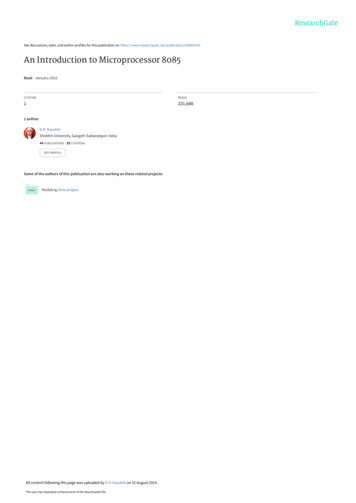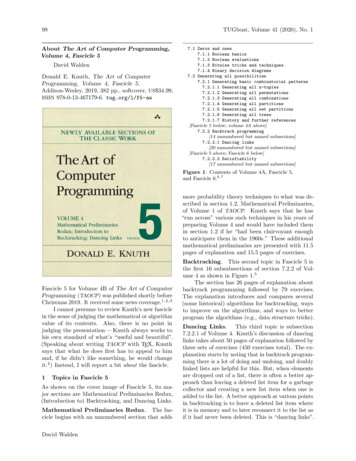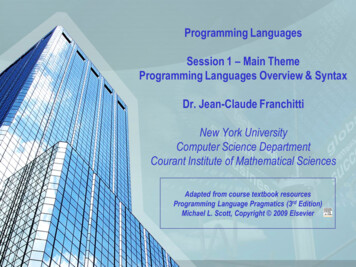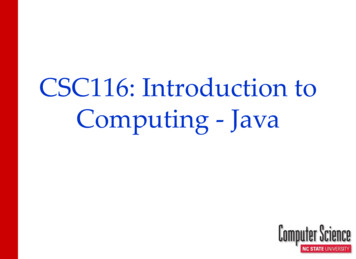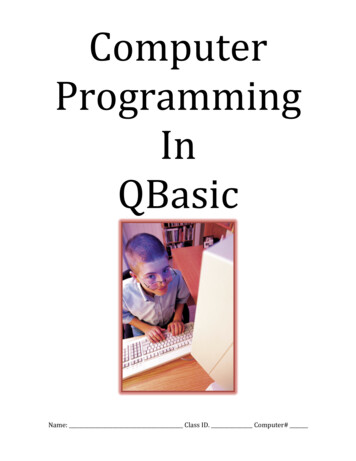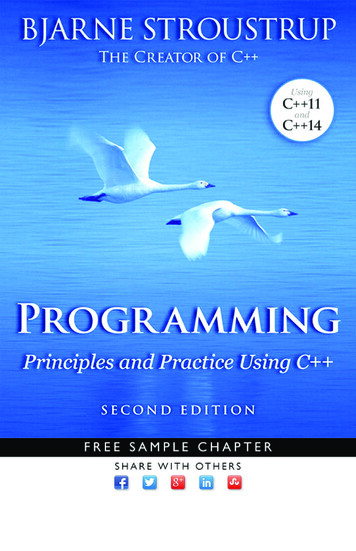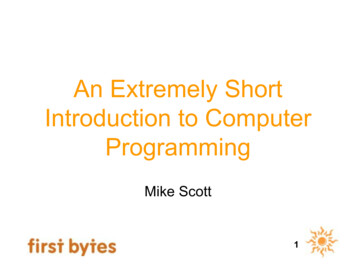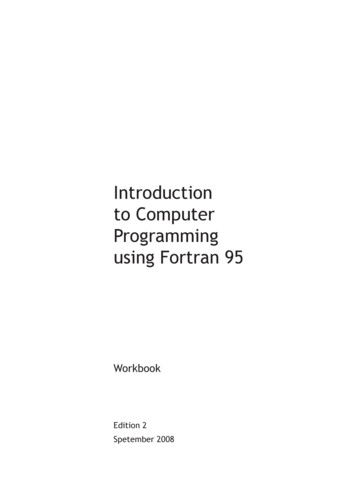
Transcription
Introductionto ComputerProgrammingusing Fortran 95WorkbookEdition 2Spetember 2008
Introductionto ComputerProgrammingusingFortran 95Edition 2, September 2008Document Number: 3570-2008
ivAcknowledgementDR. A C MARSHALL from the University of Liverpool (funded by JISC/NTI) firstpresented this material. He acknowledged Steve Morgan and Lawrie Schonfelder.Helen Talbot and Neil Hamilton-Smith took the overheads from that course andworked on them to produce this text: later Neil Hamilton-Smith revised it.Copyright IS 2008Permission is granted to any individual or institution to use, copy or redistribute thisdocument whole or in part, so long as it is not sold for profit and provided that theabove copyright notice and this permission notice appear in all copies.Where any part of this document is included in another document, dueacknowledgement is required.Introduction to computer programming using Fortran 95
Contents1.FUNDAMENTALS OF COMPUTER PROGRAMMING . 3Telling a Computer What To Do. 3Programming Languages. 3Fortran Evolution . 3Character Set . 4How Does Computer Memory Work? . 4Numeric Storage . 4Intrinsic Types. 4Literal Constants. 5Names. 5Significance of Blanks. 5Implicit Typing . 6Numeric and Logical Type Declarations .6Character Declarations . 7Initialisation. 7Constants (Parameters) . 7Comments. 8Expressions . 8Assignment . 8Intrinsic Numeric Operations . 8Relational Operators . 9Intrinsic Logical Operations. 9Intrinsic Character Operations. 9Operator Precedence . 10Mixed Type Numeric Expressions. 11Mixed Type Assignment . 11Integer Division . 11Formatting input and output . 12WRITE Statement . 13READ Statement. 14Prompting for Input . 15Reading and writing to a file. 15Intrinsic Procedures. 16Type Conversion Functions . 16Mathematical Intrinsic Function Summary. 17Numeric Intrinsic Function Summary . 17Character Intrinsic Function Summary . 18How to Write a Computer Program. 18Statement Ordering. 20Compiling and Running the Program . 21Bugs . 21Practical Exercise 1 . 232.CONTROL CONSTRUCTS AND INTRINSICS . 26Control Flow. 26IF Statement. 26IF . THEN . ELSE Construct. 27IF . THEN . ELSEIF Construct . 28Nested and Named IF Constructs . 29Example Using IF constructs. 29SELECT CASE Construct . 31Conditional Exit Loop. 33Conditional Cycle Loops. 33Named and Nested Loops. 34Indexed DO Loops . 34DO construct index . 35Practical Exercise 2 . 363.ARRAYS . 39Declarations. 39
Array Element Ordering . 40Array Sections. 41Array Conformance . 42Array Syntax . 42Whole Array Expressions. 42WHERE statement and construct . 43COUNT function . 44SUM function . 44MOD function . 44MINVAL function . 46MAXVAL function . 46MINLOC function . 46MAXLOC function . 46Array I/O. 47The TRANSPOSE Intrinsic Function . 48Array Constructors . 48The RESHAPE Intrinsic Function . 48Named Array Constants . 49Allocatable Arrays . 49Deallocating Arrays. 50Vector and Matrix Multiplication . 50Practical Exercise 3 . 514.PROCEDURES . 54Program Units . 54Main Program Syntax . 54Introduction to Procedures . 55Subroutines . 55Functions . 56Argument Association . 56Argument Intent . 57Local Objects . 57Scoping Rules. 58Host Association -- Global Data. 58Scope of Names . 59SAVE Attribute . 59Dummy Array Arguments. 60Assumed-shape Arrays. 60External Functions. 61Subroutine or Function? . 62Practical Exercise 4 . 635.MODULES AND DERIVED TYPES. 64Plane Geometry Program . 64Reusability – Modules. 65Restricting Visibility. 67The USE Renames Facility . 68USE ONLY Statement . 68Derived Types . 68Functions can return results of an arbitrary defined type .70True Portability. 70Practical Exercise 5 . 726.BIBLIOGRAPHY . 752
1. Fundamentals of Computer ProgrammingTelling a Computer What To DoTo get a computer to perform a specific task it must be given a sequence ofunambiguous instructions or a program.An everyday example is instructions on how to assemble a bedside cabinet. Theinstructions must be followed precisely and in the correct order: insert the spigot into hole A';apply glue along the edge of side panel;press together side and top panels;attach toggle pin B' to grommet C';. and so on.The cabinet would turn out wonky if the instructions were not followed to the letter!Programming LanguagesProgramming languages must be: totally unambiguous (unlike natural languages, for example, English);simple to use.All programming languages have a very precise syntax (or grammar). This ensuresthat all syntactically correct programs have a single meaning.High-level programming languages include Fortran 90, Fortran 95, C and Java. Onthe other hand assembler code is a Low-Level Language. Generally: a program is a series of instructions to the CPU of the computer;all programs could be written in assembler code but this is a slow, complex anderror-prone process;high-level languages are more expressive, more secure and quicker to use;a high-level program is compiled (translated) into assembler code by a compiler.Fortran EvolutionFortran stands for FORmula TRANslation. The first compiler appeared in 1957 andthe first official standard in 1972 which was given the name of Fortran 66'. This wasupdated in 1980 to Fortran 77, updated in 1991 to Fortran 90, updated in 1997 toFortran 95, and further updated in 2004 to Fortran 2003. At each update someobsolescent features were removed, some mistakes corrected and a limited number ofnew facilities were added. Fortran is now an ISO/IEC and ANSI standard.3
Character SetThe following are valid in a Fortran 95 program: alphanumeric:symbolic:Symbol *(,':! %?a-z, A-Z, 0-9, and (the underscore);Descriptionblankplus signasteriskleft parenthesiscommaapostophecolonexclamation markless thanpercentquestion markSymbol /).";& Descriptionequals signminus signslashright parenthesisdecimal pointquotation marksemicolonampersandgreater thancurrency symbolHow Does Computer Memory Work? Each memory location will contain some sort of value;The value stored in a location can be read, or the location can be written to;Fortran 95 allows (English) names to be given to memory locations.Numeric StorageIn general, there are two types of numbers used in Fortran 95 programs, INTEGERs(whole numbers) and REALs (floating point numbers). INTEGERs are stored exactly, often in the range [-32768, 32767].REALs are stored approximately.Their form is a mantissa and an exponent. For example 6.6356 x 1023The exponent can take only a finite range of values, typically [-307, 308].You can get numeric exceptions:overflow -- exponent is too big,underflow -- exponent is too small.In Fortran 95 you can decide what numeric range is to be supported.CHARACTERs are stored differently.Intrinsic TypesFortran 95 has two broad classes of object type: numeric;non-numericwhich give rise to six simple intrinsic types, known as default types. These aredemonstrated by the following code:4
INTEGERREALCOMPLEXCHARACTERCHARACTER(LEN whole numberdecimal numberx iyletterstringtruth valueLiteral ConstantsA literal constant is an entity with a fixed value. For CTERLOGICALNote: REALs contain a decimal point, INTEGERs do not;REALs can have an exponential form;there is only a finite range of values that numeric literals can take;character literals are delimited by " or ';two occurrences of the delimiter inside a string produce one occurrence on output;there are only two LOGICAL values.NamesIn Fortran 95 names for variables and procedures etc.: must be unique within the program;must start with a letter;may use only letters, digits and the underscore;may use the underscore to separate words in long names;may not be longer than 31 characters.REAL:: a1! valid nameREAL:: 1a! not valid nameCHARACTER:: atoz! valid nameCHARACTER:: a z! valid nameCHARACTER:: a-z! not valid nameCHARACTER(LEN 8) :: user name! valid nameCHARACTER(LEN 8) :: username! different nameSignificance of BlanksIn free form source code blanks must not appear: within keywords;within names.INTEGERINT EGERREALREAL::::::::wizzywizzyrunning totalrunning total!!!!5isisisisa valid keywordnota valid namenot
Blanks must appear: between two separate keywords;between keywords and names not otherwise separated by punctuation or otherspecial characters.INTEGER FUNCTION fit(i)INTEGERFUNCTION fit(i)INTEGER FUNCTIONfit(i)! is valid! is not! is notBlanks are optional between some keywords mainly END construct ' and a fewothers; if in doubt add a blank (it looks better too).Implicit TypingAny undeclared variable has an implicit type: if the first letter of its name is I, J, K, L, M or N then the type is INTEGER;if it is any other letter then the type is REAL.Implicit typing is potentially very dangerous and should always be turned off byadding:IMPLICIT NONEat the start of the declaration of variables. Consider:DOI 1.1000.END DOWith implicit typing this declares a REAL variable DOI and sets it to 1.1000 (andleaves an unattached END DO) instead of performing a loop 1000 times!Numeric and Logical Type DeclarationsWith IMPLICIT NONE variables must be declared. A simplified syntax follows: type [, attribute-list ] :: variable-list &[ value ]Optional components are shown in [square brackets]The following are all valid declarations:INTEGERREALREAL, DIMENSION(10,10)INTEGERLOGICAL::::::::::i, jxy, zk 4flagThe DIMENSION attribute declares an array of 10 rows by 10 columns.6
Character DeclarationsCharacter variables are declared in a similar way to numeric types. CHARACTERvariables can: refer to one character;refer to a string of characters which is achieved by adding a length specifier to theobject declaration.The following are all valid declarations:CHARACTERCHARACTER(LEN 10)CHARACTER(LEN 32)CHARACTER(LEN 10), tionDeclaring a variable does not automatically assign a value, say zero, to this variable:until a value has been assigned to it a variable is known as an unassigned variable.Variables can be given initial values, which can use initialisation expressions andliterals. Consider these examples:INTEGERREALCHARACTER(LEN 5)CHARACTER(LEN 9)LOGICAL::::::::::i 5, j 100x, y 1.0E5light 'Amber'gumboot 'Wellie'on .TRUE., off .FALSE.gumboot will be padded, to the right, with blanks. In general, intrinsic functionscannot be used in initialisation expressions. The following can be: RESHAPE,SELECTED INT KIND, SELECTED REAL KIND, KIND.Constants (Parameters)Symbolic constants, known as parameters in Fortran, can easily be set up in adeclaration statement containing the PARAMETER attribute:REAL, PARAMETER:: pi 3.141592REAL, PARAMETER:: radius 3.5REAL:: circum 2.0 * pi * radiusCHARACTER(LEN *), PARAMETER :: &son 'bart', dad "Homer"CHARACTER constants can assume their length from the associated literal (LEN *)only if the attribute PARAMETER is present.Parameters should be used: if it is known that a variable will only take one value;for legibility where a value such as π occurs in a program;for maintainability when a constant value could feasibly be changed in the future.7
CommentsIt is good practice to include many comments, for example:PROGRAM Saddo!! Program to evaluate marriage potential!LOGICAL:: TrainSpotter! Do we spot trains?LOGICAL:: SmellySocks! Have we smelly socks?INTEGER:: i, j! Loop variables everything after each ! is a comment;the ! in a character context does not begin a comment, for example:prospects "No chance of ever marrying!!!"ExpressionsEach of the three broad type classes has its own set of intrinsic (in-built) operators, forexample, , // and .AND. The following are all valid expressions:NumBabiesBorn 1! numeric valued: addition"Ward "//Ward! character valued: concatenationNewRIE .AND. Bus38 ! logical: intersectionExpressions can be used in many contexts and can be of any intrinsic type.AssignmentAssignment is defined between all expressions of the same type.Examples:a b - cc SIN(.7)*12.7! SIN argument in radiansname initials//surnameThe LHS is an object and the RHS is an expression.Intrinsic Numeric OperationsThe following operators are valid for numeric expressions:** exponentiation is a dyadic operator, for example, 10**2, (evaluated right to left);* and / multiply (there is no implied multiplication) and divide are dyadic operators,for example, 10*7/4; and - plus and minus or add and subtract are monadic and dyadic operators, forexample, -3 and 10 7-4;They can be applied to literals, constants, scalar and array objects. The onlyrestriction is that the RHS of ** must be scalar. As an example consider:a b - cf -3*6/28
Relational OperatorsThe following relational operators deliver a LOGICAL result when combined withnumeric operands:.GT.GE.LE.LT.NE.EQ. / greater thangreater than or equal toless than or equal toless thannot equal toequal toFor example:bool i jIf either or both expressions being compared are complex then only the operators and / are available.Intrinsic Logical OperationsA LOGICAL expression returns a .TRUE. or .FALSE. result. The following arevalid with LOGICAL operands:------.NOT.AND.OR.EQV.NEQV.TRUE. if operand is .FALSE.;.TRUE. if both operands are .TRUE.;.TRUE. if at least one operand is .TRUE.;.TRUE. if both operands are the same;.TRUE. if both operands are different.For example, if T is .TRUE. and F is .FALSE.TTTT.NOT. T.AND. F.OR. F.EQV. F.NEQV. Fisisisisis.FALSE.FALSE.TRUE.FALSE.TRUE.TFFF.NOT. F.AND. T.OR. F.EQV. F.NEQV. Fisisisisis.TRUE.TRUE.FALSE.TRUE.FALSE.Intrinsic Character OperationsConsider:CHARACTER(LEN *), PARAMETERCHARACTER(LEN *), PARAMETERCHARACTER(LEN 9):: str1 "abcdef":: str2 "xyz":: str3, str4Substrings can be taken. As an example consider:str1str1(1:1)str1(2:4)is “abcdef”is “a” (not str1(1) which is illegal)is “bcd”9
The concatenation operator, //, is used to join two strings or substrings:str3 str1//str2str4 str1(4:5)//str2(1:2)would produceabcdefxyzdexystored in str3stored in str4Operator PrecedenceOperatoruser-defined monadic*** or /monadic or dyadic or // , , etc.NOT.AND.OR.EQV. or .NEQV.user - defined dyadicPrecedenceHighest.LowestExample.INVERSE. A10 ** 489 * 55- 45 4str1 // str2A B.NOT. BoolA .AND. BA .OR. BA .EQV. BX .DOT. YNote: in an expression with no parentheses, the highest precedence operator iscombined with its operands first;in contexts of equal precedence left to right evaluation is performed except for **.Consider an example of precedence, using the following expression:x a b/5.0-c**d 1*eBecause ** is highest precedence, / and * are next highest, this is equivalent to:x a (b/5.0)-(c**d) (1*e)The remaining operators' precedences are equal, so we evaluate from left to right.10
Mixed Type Numeric ExpressionsIn the CPU, calculations must be performed between objects of the same type. So ifan expression mixes type some objects must change type. The default types have animplied ordering:1.2.3.COMPLEXREALINTEGER-- highest-- lowestThe result of an expression is always of the higher type, for example:gives REAL , (3*2.0 is 6.0)gives REAL , (3.0*2 is 6.0)gives COMPLEXINTEGER * REALREAL * INTEGERCOMPLEX * anytype The actual operator is unimportant.Mixed Type AssignmentProblems can occur with mixed-type arithmetic. The rules for type conversion aregiven below: INTEGER REALThe RHS is evaluated, truncated (all the decimal places removed) then assigned to theLHS.REAL INTEGERThe RHS is evaluated, promoted to be REAL (approximately) and then assigned tothe LHS.For example:REAL :: a 1.1, b 0.1INTEGER :: i, j, ki 3.9! i will be 3j -0.9! j will be 0k a – b! k will be 1Note: although a and b are stored approximately, the value of k is always 1.Integer DivisionDivision of two integers produces an integer result by truncation (towards zero).Consider:REAL :: a, b, c, d, ea 1999/1000b -1999/1000c (1999 1)/1000d 1999.0/1000e 1999/1000.0!!!!!LHSLHSLHSLHSLHSa is (about) 1.000b is (about) -1.000c is (about) 2.000d is (about) 1.999e is (about) 1.999Great care must be taken when using mixed type arithmetic.11
Formatting input and outputThe coding used internally by the computer to store values is of no concern to us: ameans of converting these coded values into characters which can be read on a screenor typed in from a keyboard is provided by formatting. A format specification is a listof one or more edit descriptors enclosed in round brackets. Each edit descriptor givesthe type of data expected (integer, real, character or logical) and the field width(counted in number of characters, non-blank or otherwise) of this data value and howthe data item is represented within its field. Edit descriptors can be:EditDescriptorValue ating mericGeneralL1A11G11.3Valueexample1 or -56001.00 or -273.180.10E 01 or-0.27E 03T'one billion'3.14The field width is given by a number which immediately follows the letter, unless theletter is X in which case the number precedes the letter.A blank space is simplest of the edit descriptors to specify, consisting of the letter X.For example, X means ignore the next character position in the current input line, orleave a gap 1 character wide in the current output line. Multiple spaces are indicatedby preceding the X by an integer count value, so 2X means skip two positions in theinput line or leave two spaces in the output line.
Introduction to computer programming using Fortran 95 Acknowledgement DR. A C MARSHALL from the University of Liverpool (funded by JISC/NTI) first presented this material. He acknowledged Steve Morgan and Lawrie Schonfelder. Helen Talbot and Ne
